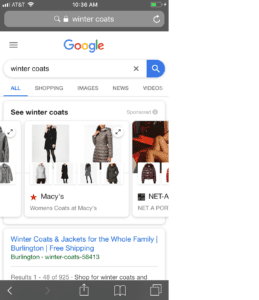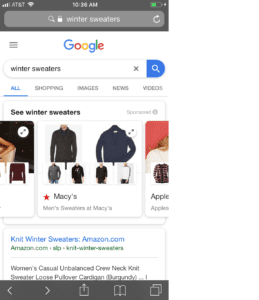Google has been beefing up its showcase shopping ads product to help retailers spice up their holiday advertisements. Showcase shopping ads make it possible for businesses to group together related products to merchandise them more effectively. The format is tailored for mobile viewing. Recently Google added new features such as video to make these ads more powerful. At True Interactive, we’ve been applying showcase shopping ads with favorable results. One of our clients running showcase shopping ads has seen an 80-percent higher click-through rate over standard shopping ads. This blog post explains showcase shopping ads based on questions we’ve received.
What exactly are showcase shopping ads?
Showcase shopping ads appear as a collection of shoppable images displaying different products offered by an advertiser. The ads are built to capitalize on broad keyword searches such as “winter sweaters.” The showcase shopping ads work this way:
- Someone making a non-brand search for, say, winter sweaters will see in their search results display ads from different retailers with winter sweaters and promotional ad copy.
- When the shopper clicks on the ad, they are taken to a landing page with a merchant’s line of winter sweaters. The shopping ad display, or showcase, resembles a brand page to the user, consisting of products the advertiser wants the user to see.
A shopper may click on an inventory and complete a purchase.
A business can create multiple showcase shopping ads. The header image can be different based on what is uploaded into each showcase shopping ad. In the above example of winter sweaters, a retailer could run a header image that focuses on sweaters but have another header image that focuses on outerwear for a “winter coat” search. The Google algorithm chooses which products appear based on variables such as the product titles, description, and type.
Who is this a good fit for?
It is highly recommended that you have at least 1,000 products in your inventory. There is no minimum budget. The format is effective for anyone who wants to get their products in front of a large audience because it’s based on broad keywords. It’s not for people competing for specific keywords. For bigger advertisers, showcase shopping ads are a good way to display multiple products for broad keywords. You can create an engaging photo and additional messaging that smaller businesses may not be able to afford.
Why is Google beefing up showcase ads?
The main reason Google is pushing showcase ads is that they are optimized for mobile. Salesforce recently predicted that mobile devices would dominate both traffic and orders for the entire 2018 holiday shopping season (68 percent of traffic and 46 percent of orders). On Black Friday alone, retailers saw $2.1 billion in sales from smartphones, accounting for 33.5 percent of Black Friday sales. The rise of mobile reflects broader shopping trends, and Google wants to capture a share of ad revenue associated with mobile shopping by offering a shoppable ad format.
What is the pay model?
The pay format is cost per engagement, not cost per click. The user has to be on the ad for 10 seconds or more, at which time the advertiser is charged. This approach can be a drawback. A click is a specific action. But having a page open for 10 seconds is a passive way to measure user intent. A person may not be really engaged with a product while a screen is open.
Any tips for getting the most out of Google showcase shopping ads?
Yes. Advertisers need to do two things:
- Ensure all your products are grouped together in an easily findable way.
- Have your products accurately labeled in each ad group.
Bottom line: Google showcase shopping ads give multiple advertisers a way to showcase multiple products for generic keywords that can otherwise be very expensive. If you compete for generic keywords in a mobile centric world – and who isn’t? – then you should consider Google showcase shopping ads. If you need help getting started or if you are running Google showcase shopping ads and want to take your game to the next level, contact True Interactive. We’re here to help.


